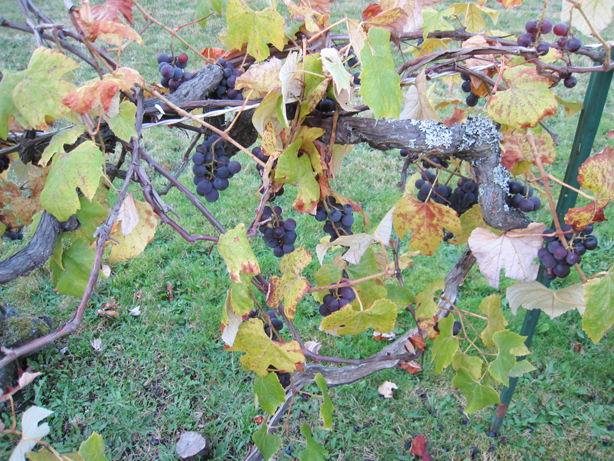Plant of the Month: October 2007
|
| Grape Vine |
| Vitis vinifera L. |
VITACEÆ; Grapevine Family
|
| The original vine is Vitis vinifera, the GRAPE of fame and history. It likely was native originally in SW Asia, but was cultivated thousands of years ago in Egypt, along with dates, figs, pomegranates and the like. Later the grape made it to Greece, Italy ("vite"), France ("vigne"), Spain ("La vid") and so on. Fermented grape juice is called wine. Nowadays many other plants are called vines, though the British often prefer to reserve the name vine exclusively for the grape plant, also called the wine grape or common grape. In the Language of Flowers the vine symbolizes intoxication, and the wild grape reckless mirth. The Greek God Dionysus (the Roman Bacchus) is associated with wine. In modern times, the name "grape" has been applied not only to many other of the 65 species of Vitis, but also to unrelated plants such as Oregon grape (Mahonia or Berberis Aquifolium). In this article I supply an introduction to the original grapevine, and its hybrids, with special emphasis on their culture in Seattle. |
| Grapes are cultivated for different reasons. Wine-making is just the main motive. There also may be a desire for: grape juice production; table or dessert grape production; raisin production; leaf production for edible leaves; ornamental or decorative value in the landscape; grape seeds yield a polyunsaturated oil used in cosmetics and cooking; even forage for animals at a zoo --gorillas love grape bark. |
| My deceased friend Gary Lockhart wrote in his unpublished book Herbs of the Inside: "In Biblical lore, Noah was the first man to plant a vineyard and make wine, and also the first man to get drunk. There is a Jewish story that when Noah planted that vineyard, Satan poured in succession the blood of a lamb, a lion, an ape and a pig over the soil. Then Satan said: When man shall drink one cup, he will be like a lamb --meek and humble. After two cups he will be as strong as a lion, but three or four cups will make him like an ape. After more than that he will roll in the mud like a pig." |
| The grape is a deciduous woody vine, also called a climber, or liane. Unpruned, it can gradually swallow a tree, growing at least 60 feet high. If you have seen only neatly pruned grapes in vineyards, keep in mind that such specimens are cultivated for maximum fruit yield and easy harvest, while uncultivated grapes romping up trees will make more leaves and less fruit. The grapes climb by way of little coiling tendrils. The stems bear a tendril opposite each leaf. The leaf is long stemmed and vaguely recalls a maple leaf, being broad and lobed. Fresh clean grape leaves are stuffed and rolled to make dolmades, edible delicacies. The tender young grape tendrils are edible as raw nibbles. |
| Typically the vines produce tiny greenish flowers in June, that bring forth the berry crop (grapes) in late summer or fall, depending on the exact varietal (cultivar), the year, and the location. In Seattle, the earliest grapes tend to ripen in August; some are ripe only by late October or early November; some receive insufficient heat-units to ripen fully at all. |
| Grape culture in Seattle involves, ideally, several elements. A relatively warm, sunny site should be chosen. Some sort of support is needed, whether it be low, or high, man-made or a tree. It ought to be such as affords ease of pruning and harvesting, and preferably such as is harder rather than easier for raccoons to access. The soil should be limed; other than that it can be loam, or sandy or even wet heavy clay, too, though the latter is not ideal. In the summer, some watering may be desirable, although an established plant will get by without help. The amount, if any, of watering, depends on the kind of grape, its location, and the year's weather. If you are harvesting crops each year, you should fertilize. If grapes are pruned only once a year, it is best in late winter, right as the buds swell. The goal is to remove the dead twigs, small weak twigs, and crowded branches, to ensure an evenly spaced, strong framework. But I do summer pruning as well, to shorten long shoots, giving more sunlight to the fruit clusters, and keeping the vigor of the vine somewhat checked. |
| The majority of grape growers in Seattle choose table or dessert grapes rather than wine grapes. Wine grapes, on the whole, tend to be smaller, and seedy; the leaves are thin and scarcely or not hairy. Table grapes tend to be hybrids with larger fruit, often seedless, and they are relatively sweet and thicker skinned; the leaves are thicker, less lobed and pale underneath with close hairs. I notice wine grapes sprouting as seedlings in various places, because birds eat the berries and defecate the seeds. But I have not seen hybrid seedlings in Seattle, perhaps because hybrids are either infertile or seedless. You can make wine from any grape, but the table grape wines I have tasted made me wish their juice had not been fermented; I prefer delicious juice to sour wine. |
A reliable sweet green (white) table grape for Seattle is 'Interlaken Seedless.' Though you can grow 'Concord' here, a similar type that is more productive is called variously 'Island Belle' or 'Early Campbell'. The photos below show a 'Concord' (photographed October 10th) and a wine grape that may be 'Cabernet Sauvignon' (photographed September 5th)
Back |

Concord grape photo by ALJ |

wine grape photo by ALJ |
|
|

